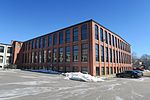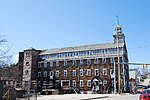Pawtuxet Valley Dyeing Company
Buildings and structures in Coventry, Rhode IslandIndustrial buildings and structures on the National Register of Historic Places in Rhode IslandKent County, Rhode Island Registered Historic Place stubsNational Register of Historic Places in Kent County, Rhode Island

The Pawtuxet Valley Dyeing Company was a historic mill complex at 9 Howard Avenue in the town of Coventry, Rhode Island. The complex included three buildings: the main mill building and two pump houses, as well as the dam which impounds the Pearce Mill Pond, and the tailrace which evacuates water from the mill into the North Branch Pawtuxet River.
Excerpt from the Wikipedia article Pawtuxet Valley Dyeing Company (License: CC BY-SA 3.0, Authors, Images).Pawtuxet Valley Dyeing Company
Howard Avenue,
Geographical coordinates (GPS) Address Nearby Places Show on map
Geographical coordinates (GPS)
| Latitude | Longitude |
|---|---|
| N 41.723611111111 ° | E -71.538055555556 ° |
Address
Howard Avenue 16
02816
Rhode Island, United States
Open on Google Maps








